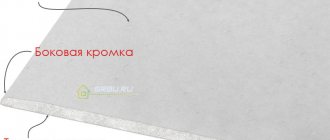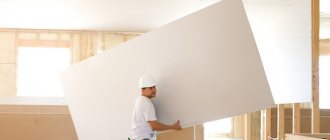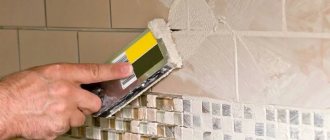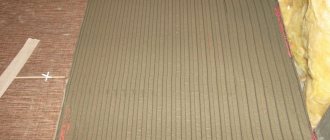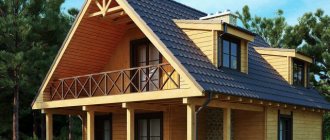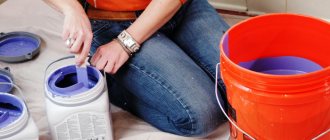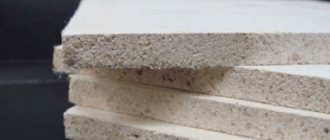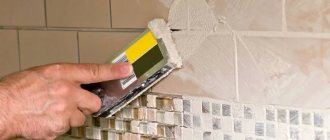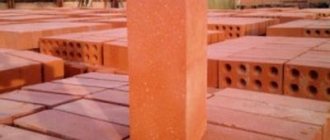Soft roofing is considered the best choice for covering flat concrete roofs. It is also good for stingrays, provided that the material is selected and laid correctly. Let's look at the video in detail on how to cover a roof with roofing felt with your own hands. With its help, you can equip the roof of a house, barn, utility room, garage.
- Foundation
Roofing felt for the foundation: features of choice and technology of waterproofing work
Classification of roofing felt
What is roofing felt? This is thick cardboard impregnated with petroleum bitumen. Next, it is coated on both sides with refractory bitumen and sprinkled with stone chips on one side. The latter serves to prevent the sun's rays from melting the bitumen layer, plus it is protection from mechanical loads.
Today, instead of cardboard, manufacturers use fiberglass cloth, which increases both the strength of the material and its service life. For example, cardboard roofing felt will last on the roof for 5-7 years, fiberglass - up to 15.
Now about classification, because before laying roofing felt, you need to choose it correctly. And let's start with the sprinkles, since we're talking about it.
- Coarse-grained . This is a classic stone chip, so the material sprinkled with it belongs to the “universal” category. That is, it can be used to cover roofs, as a substrate, and as a waterproofing material.
Roofing felt with coarse powder Source stroy-ka.ru
- Flaky , where the raw material for sprinkling is mica. This roofing material is used only as a roofing material.
- Fine-grained . Sand is used here as a topping, so it is not suitable as a finishing coating for a roof structure. But it is used everywhere as a lining layer for a roof or as a waterproofing layer.
- Dust-like . This type of topping received its name due to the fact that either chalk or talc is used as it. It is clear that it is impossible to put such material on the roof as a finishing coating. Therefore, it is used in waterproofing processes and when creating a roofing pie, as a lining.
Ruberoid with dusty topping Source plot.kz
Attention! Please note that the sprinkles have different colors. For the finishing coating, it is recommended to use roofing felt that is not black or gray. Both shades attract the sun's rays without reflecting them. This means that the roofing material will heat up more, collapsing faster.
It is the topping that answers the frequently asked question, which side to put the roofing felt on. It is clear that the protective coating is facing up.
Roofing felt is laid with the topping facing up Source selma.com.ua
Material marking
The roofing felt itself is divided into two main types: roofing and lining. The first is used as a finishing coating for roofing structures, the second for waterproofing and as a lining layer when constructing a roofing pie. What type of material you are purchasing is indicated by its labeling.
The first letter is “P”, that is, this is the designation of roofing material. The second letter is either “K” or “P”. The first designation is roofing type, the second is lining type. It should be noted right away that the thickness of the roofing felt is 4-5 mm, the lining 3-3.5.
The third letter indicates the type of topping:
- “K” – coarse-grained;
- “H” – scaly;
- “M” – fine-grained;
- “PP” – dusty.
Next in the marking is a digital designation that determines the weight of the base, meaning cardboard or fiberglass, per 1 m² of material. If temperature differences in the building area are large, then it is recommended to purchase roofing material with a base weight of at least 400 g.
An example of roofing felt marking Source legkovmeste.ru
Varieties
The scientific and technical process does not stand still. The emergence of new technologies also affected the production of roofing felt, which is why more than 60 varieties of this material appeared on the market. And although everyone calls them, as before, roofing felt. But other names began to appear in rumors. Here are three of them that have gained particular popularity:
- Rubemast is practically no different in appearance from its classic counterpart. But in its production, modified bitumen is used, which contains mineral additives. The topping is granite chips, which is why the weight of the material itself increased to 2 kg/m². This is five times more than the classic version.
Rubemast - soft roofing Source legkovmeste.ru
- Steklomast . In fact, this is the previous version, only the base is made of fiberglass, plus the thickness of the bitumen layer has been increased, causing the weight of the material to be in the range of 4-5 kg/m². Steklomast has high frost resistance and a service life of 15 years.
- Euroroofing material . This is a completely different material, unlike the previous ones. Firstly, its base is fiberglass. Secondly, a mixture of synthetic rubber and bitumen is used as impregnation. By adding each other, they improve the waterproofing characteristics of the material. Thirdly, the topping is mineral crumbs. Euroroofing felt will last on your roof for up to 30 years. At the same time, he is not afraid of severe frosts.
Euroroofing material will last 30 years Source kak-peresadit.ru
Preparing the roof base
The roof base must be dry and level, without large holes or bumps. There should also be no resin on it. Only after this can mastic be applied to it. In the past, garage roofs were covered with tar paper, which was bonded solely to resin. This method is still applicable today.
Some craftsmen cover the roof only with resin. If you decide to make a roof in this way, then you should take into account that the resin will crack over time, as a result of which the roof will leak. Resin, as a roofing material, is unsuitable for use.
It is almost impossible to correct defects in a resin roof. You will have to fill it with a thick layer of resin and cover it with many layers of roofing felt. The cause of moisture accumulation on the roof can also be microcracks in the resin. If you cover the coating with roofing felt, then condensation will accumulate in such cracks. The same result will be observed if a new roofing material is laid on a damaged resin roof.
If you have to re-roof a house or garage, the old covering should be removed. The basis for the new roof should be a reinforced concrete floor/screed.
The base of the roof has been cleaned.
Irregularities in the reinforced concrete floor can be easily eliminated by pouring a screed, which should be done with a slight slope to ensure unhindered water flow. The cement screed should be poured along the beacons set at the water or hydraulic level.
Installation process
Having dealt with the types of roofing material, we move directly to the answer to the question of how to cover a roof with roofing felt. Let us immediately note that the classic version of the technology is for hot bitumen. That is, ordinary bitumen, which was brought in pieces, was heated in a metal barrel, usually over a fire. After which it was applied to the concrete surface of a flat roof using a roller, a brush or a wide brush, and the roofing material was laid in strips with overlapping sides within 10 cm.
Roofing felt was laid out on a flat roof in two layers, where the top one was covered with material with coarse sprinkles, and a lining type was laid underneath. In this case, both layers were laid out in perpendicular directions. Heated bitumen is also applied between layers. That is, a four-layer coating was obtained.
Over time, the number of layers began to be increased, because a two-layer application lasted at most 2 years. At the same time, this technology began to be used for pitched roof structures. Here are the recommendations regarding the number of layers:
- if the angle of inclination of the roof slope is 45°, then the roofing material must be laid in two layers;
- tilt 20-25° – three layers;
- less than 15° – four layers.
Installation of roofing felt on hot bitumen Source rmnt.ru
See also: Catalog of companies that specialize in roofing materials.
Please note that the top strips should always be laid along the slope, that is, from the ridge of the roof to its overhang. And they should be the roofing modifications. That is, it becomes clear which side to put the roofing felt on the roof.
As for the lower layers, which are mounted across, there is one subtlety. They begin to be laid from the overhang to the ridge. In this case, the edges of the upper strips should cover the edges of the lower ones with an overlap of up to 10 cm.
If the angle of inclination of the slope of the roofing structure is large enough - more than 30°, then it is recommended to use additional fastening in the form of roofing nails, which are driven into the edges of the strips every 15 cm. This is the question of how to attach roofing felt to a wooden roof. In this case, the place of clogging is 2-4 cm from the edge of the laid strip of roofing material. The nails themselves must be driven strictly perpendicular to the surface to be covered, that is, the plane of the roof slope.
Installation of roofing felt on nails Source roof-tops.ru
What would you like to add in this section? Today no one uses hot bitumen anymore. On the market you can purchase a completely unique material called bitumen mastic. It comes in two types: hot and cold. The difference between the two varieties is that the first is heated before use, the second is used cold.
Both types of mastic can be used to lay roofing felt on the roof. It’s just that the cold version is easier to use, which is why it is more popular. The process of applying mastic itself is as follows:
- the jar opens;
- the mastic is mixed in it;
- dip a brush or roller with which the material is applied to the prepared roofing surface.
At the same time, mastic, like bitumen, performs two functions at once: waterproofing and fastening. Another advantage of mastic over bitumen is that it is applied in a thin layer.
Laying on bitumen mastic Source tehnolen.ru
Self-adhesive roofing felt
Today this variety is very popular among country developers. Because the installation process of this roofing covering is very simple. This does not require additional fasteners or materials. The thing is that the reverse side of the roofing material is covered with a special adhesive composition, which is attached to any surface of any material. This composition is covered with plastic film, which must be removed before placing the roofing material on the roof.
Today, even wooden roofs are covered with this self-adhesive material. Briefly how to do it:
- first, a roofing pie is formed, that is, insulation is laid between the rafters, covered with a vapor barrier membrane on top, and then either moisture-resistant plywood sheets, or OSB boards, or boards are laid;
- the wooden surface is treated with drying oil or any other protective compound that will additionally damage the surface;
- and after it dries, the installation of roofing felt begins.
Laying self-adhesive roofing felt Source verbouw-prijzen.be
Calculation of material quantity
If you plan to do all the work yourself, you need to start with calculations. First, it is determined how many layers of fabric will be needed. To do this, you need to know the type of roof: whether it is flat or pitched. In the latter case, you need to know the angle of inclination of the plane. The smaller it is, the more layers will have to be laid so that the soft roof does not leak. For the general calculation, the following scheme is adopted:
- A slope with a slope of 35-45° is covered with two layers.
- A sloping plane of 15-30° is covered with three layers.
- Flat and low-slope slopes are covered with 4-5 layers.
These are general calculations. You need to know that experienced craftsmen do not advise covering a roof with a slope of more than 15° only with roofing felt. They advise using it in such cases as a lining under metal tiles, ondulin or corrugated sheets. Coating consumption is calculated after the number of layers is determined. To do this, calculate the pitched area, then divide it by the area that can be covered by one roll.
Instagram elastomeric_systems
It must be taken into account that the strips are laid with an overlap of 150-200 mm. Another important point is that you need to buy different materials for the lower and upper layers. The quantity of each type is calculated.
Video description
The video shows how to correctly lay roofing felt on a roof, meaning rubemast:
Typically, flat roofs were previously covered with this method. Today, pitched structures are subject to such operations. This, of course, has its own difficulties, but even home craftsmen can overcome them if they strictly follow the recommendations of professionals.
The most important thing in carrying out the work is to ensure the flatness of the planes of the pitched roof, which is achieved by continuous sheathing of boards or OSB slabs. And one more nuance. In order not to expose yourself to danger on the roof slope, you must:
- follow safety rules, for example, tie yourself with a rope to the ridge of the roof structure, and also provide a pedestal under your feet in the form of a staircase;
- attach the roofing material itself to the ridge with nails so that the roll does not move out or become warped.
Coating technology
Lay sheets of roofing felt across the slope of the roof. Do this from the eaves, from bottom to top. The amount of lateral overlap is determined taking into account the wind rose - 10–20 cm. So that the wind does not tear off the layers. The same applies to laying roofing felt from the pediment.
Step by step
- The first layer of roofing felt is laid on the prepared base with bitumen, with an overlap of 15–20 cm. This is done parallel to the edge of the roof. The ends should be folded under the edge of the roof and secured with battens and slate nails at 50cm intervals.
- Then coat the layer with mastic and lay the next one overlapping over the ridge. The edges should also be folded.
- Apply bitumen mastic again and lay the finishing layer of roofing felt. Lay the layers offset by 1/3 or 1/2 sheets. This is necessary so that the seams of the top layer are not located at the same level as the bottom. To do this, cut the first sheet of roofing material in half or bend it onto the side, and the subsequent ones will move as a result.
Video description
The video shows how to properly lay roofing felt on a wooden roof:
Liquid roofing felt
This is a new approach to solving problems such as the formation of roofing and its repair. Let's start with the fact that liquid roofing felt is no different from classic roofing felt in its operational and technical characteristics. But in composition it is a plastic mass, somewhat similar to plasticine, which, when applied, is simply spread over the prepared roofing surface.
The basis of the material is bitumen, to which polymer and mineral components are added, as well as plasticizing additives. Let us add that this roofing coating has high adhesive properties, so it can easily be applied to concrete, wooden, and metal bases.
Today, manufacturers offer several modifications of this material, which differ from each other in the manufacturing recipe. For example, the PBK-1 brand is a liquid roofing material that contains thermoplastic elastomer. This substance prevents cracking of the applied layer at both low and high temperatures. Therefore, it is most often used for the finishing coating.
Liquid roofing felt brand PBK-1 Source arther-d.livejournal.com
Laying on bitumen mastic
Today there is no need to melt bitumen resin yourself, since ready-made mastic from it is sold in construction stores. Melting bitumen resin takes a lot of time, and besides, it can be unsafe and there is a high risk of getting burned.
Bitumen can be diluted with gasoline. The consistency should resemble jelly in appearance. Afterwards, you should add used engine oil, which can be purchased at your nearest service station.
This composition does not crack and glues the roofing material well to the base of the roof. However, keep in mind that the mastic has a pungent odor and will quickly ignite until it dries.
Video description
The video shows one of the technologies on how to cover a roof with liquid roofing felt with your own hands:
Advantages of liquid roofing felt
Let's just list the advantages of this material:
- highest waterproofing qualities;
- easily tolerates temperature changes and mechanical loads;
- ease of installation;
- ease of use;
- low consumption of the material itself;
- used in various fields of construction.
Regarding the last point, it must be said that in addition to roofing coverings, liquid roofing material is used to insulate foundations and metal structures. And, of course, for carrying out repair work on roofs that are covered with classic roofing felt, built-up or self-adhesive. To do this, the defective area is freed from worn-out material, and a liquid mass is applied in its place.
Waterproofing using liquid roofing felt Source dompodrobno.ru
Laying on a gable roof
To lay roofing felt on a gable roof you will need a long ladder. This is necessary in order to nail the sheathing to the highest part of the roof. In this case, you need to work harder to roll out the roll. You need to hang the roofing material on a hook/pipe, which will look like a spool of thread.
Laying process diagram
Briefly about the main thing
So, the article covered the topic of how to properly cover a roof with roofing felt, and also examined additional sections: which side to lay the roofing felt on, how to fasten the roofing felt, and the varieties of this material were identified. I would like to add that this roofing covering has been known to builders for a long time. Its peak of use occurred in the 60-70s of the last century. Today, roofing felt is gradually gaining its former popularity due to changes in the components that are added to it. It is still the cheapest roofing material, but with good technical and performance characteristics.
| Ea little more attention Do you think laying roofing felt with your own hands is worth the time spent on it, or should everyone mind their own business? |
Ratings 0
Read later
Preparatory work
Before using roofing felt, it is necessary to unroll the rolls for about a day, this is necessary so that the roofing felt does not twist during operation.
Before starting work, you need to study the weather forecast; the day should not be rainy, not cloudy, and the temperature should be at least 20 degrees Celsius.
First of all, the surface is lubricated with bitumen-based mastic. There are a large number of mastics, and their choice depends on the type of roofing felt.
To select the right materials, we recommend consulting with the staff of a hardware store. Today, roofing felt with a self-adhesive surface is available for sale, which speeds up and facilitates the installation process.
When laying such roofing felt, its sheets are laid very evenly and in parallel. You should pay close attention to the joints between the roofing felt and the walls; there should be no gaps in these places.
We conclude that at low cost and time, it is possible to create reliable roof protection; roofing felt is excellent for this.
Popular manufacturers: what does the modern market offer?
Let's compare the products of the most famous roofing felt manufacturers in Russia: what they will please you with, what they are working on and what are the highlights.
TechnoNIKOL: domestic leader in the production of bitumen roofing
The well-known Russian company TechnoNIKOL is also developing more modern types of roofing felt. Its products are supplied to 95 countries:
The main difference between the company and its competitors is that TechnoNIKOL has more modern equipment at its factories and is computer-controlled, and also has its own research laboratory. Among the options for roll roofing, Technonikol offers glassine, roofing felt and its more modern analogues, such as bikrost. Buyers especially liked the classic roofing material, which is of fairly high quality.
In total, Technonikol produces two lines of roofing felt - classic and improved, with an increased bitumen layer on both sides at once. It is still correctly called rubemast, although some, out of habit, still mistake it for roofing material and, for convenience, try not to separate all these types. Although in some ways they are right: in essence, this is a built-up roofing material, the characteristics of which are already closer to such roofing materials as those containing fiberglass or polyester reinforcing frames.
And, despite the fact that for such work you will need a gas burner with all the dangers of such roofing work, it is still much easier to fuse roofing felt than to glue it to bitumen. Is it true!
Yugstroykrovlya: special technologies
Quite practical roofing felt is also produced by Yugstroykrovlya. It appeared in the early 2000s, but has already established itself as a reliable manufacturer. The roll roofing produced by this company is of high quality and affordable. In addition to traditional roofing felt, Yugstroykrovlya also produces rubemast, mastic and steklogidroizol.
The roofing material from Yugstroykrovl is especially good because it does not stick together even in extreme heat. The only downside we note is that this company does not have its representatives in the central and northern regions of Russia.
Soft roofing: time-tested quality
Soft Roofing is one of the oldest factories in Russia, operating since 1932. Today it is equipped with automated lines that are specialized for the production of cardboard and bituminous materials.
The manufacturer emphasizes that it produces environmentally friendly raw materials and has the necessary quality certificates for absolutely all products. This roofing material is also supplied to the Far East and CIS countries:
Omskrovlya: specialization in roofing felt
The Omskrovlya company is also quite famous. This plant is called a cardboard-roofing felt plant for a reason, and it was built back in 1970.
Even today, it is within these walls that a gear-type installation operates. It produces high-quality bitumen from West Siberian oil. And it is good because it contains the optimal content of resins and oils. Roofing material from Omskkrovli turns out to be frost-resistant and plastic, thanks to which it is supplied even to the CIS countries. The only complaint that buyers have against this company is that its products are not available in all regions of the country.
KRZ and DRZ plants: regular supplies of roofing felt
Another good manufacturer of roofing felt is the KRZ company. This is a Ryazan enterprise with a long history. At one time, it produced good bitumen shingles, which became famous throughout the country. Today, KRZ also produces roofing felt and rubemast, which are affordable and resistant to weather conditions.
And finally, another well-known company in Russia is DRZ. This brand has two types of roofing felt: underlayment material, which is suitable for creating roofing underlayment and roof waterproofing, and high-density roofing felt with a mica or quartz sand coating. This is perfect for the finishing layer of the roof.
Therefore, if you are thinking about waterproofing your roof with roofing felt, do not hesitate - this material today is significantly different from the one that was produced literally ten years ago. And thanks to the spectacular colored coating and various modifications, the roof itself turns out neat and durable. Want to check it out?
Roof repair
You can cover the roof with roofing felt without removing the old coating if the roof is made of the same material or shingles. At the preliminary stage, you should thoroughly clean the old coating, paying special attention to the seams between the panels. In addition, it is necessary
:
- thoroughly clean problem areas;
- carefully cut off the torn fragments into whole sections;
- using cross-shaped cuts, open water and air bubbles;
- securely glue the exposed areas with mastic;
- remove old fasteners (metal strips, slats) so that they do not damage the new canvas;
- dry the old roof.
Roofing repairs using roofing felt are performed using a material whose protective layer is made of stone chips. To lay a new roofing covering, it is recommended to use aluminum tape and fastening nails of the required length, choosing them taking into account the overall thickness of the roofing pie.
Kinds
Depending on the functions performed, a distinction is made between roofing felt and waterproofing felt. This division is determined by the type of coating, which is applied to thick roofing cardboard coated on both sides with bitumen.
Ruberoid with sand, talc, and chalk coatings is used only for waterproofing in the inner layers of the roof. The coarse-grained fraction is used to produce roofing felt for the finishing coating.
Recommendations for purchasing
To choose the right roofing material, you need to carefully study the markings on the roll and pay attention to its appearance. Strong paper packaging is used on top, the edge of the canvas is not wrinkled, without tears.
The roll should be tightly rolled, not contain sticky areas, the bitumen coating should be uniform, without gaps or light spots. It is necessary to clarify the date of manufacture and expiration date.
When purchasing, you should choose a product produced by well-known and well-established manufacturers, which will practically eliminate the possibility of purchasing low-quality roofing material
Arrangement of a pitched roof
A pitched roof requires the installation of continuous sheathing, since it is necessary to provide a flat, rigid surface of the structure. Properly executed roofing felt sheathing allows you to avoid the appearance of unevenness in the roofing covering, which can cause rapid wear or damage in strong winds. Can be used for making sheathing
:
- board, edged or unedged;
- DSP or OSB boards;
- plywood.
To ensure that the pitched roof is reliably covered, you can use one of three installation methods
:
- with a horizontal arrangement of the canvases (installation starts from the cornice, the canvases are laid with an overlap (10 cm) on top of the bottom strip);
- along the slope line (the canvases are laid from the pediment, the side overlap is 10 cm);
- combined technology - the bottom layer is laid across, the top layer along, or vice versa.
Be sure to read: Technology and diagram for laying soft roofing
All methods provide reliable protection against moisture penetration. If the roof is covered with roofing felt using the first method, an assistant is required to support the second edge of the sheet, otherwise the roofing felt will have to be temporarily secured, violating its integrity.
Before laying the material, it should be cut in advance into pieces of the required length. On pitched roofs it is attached mechanically. In this case, it is recommended to fasten the canvas of the lower layer using nails with wide heads. To install the outer covering, wooden slats or a solid metal strip are used. Preference should be given to an aluminum strip, since the steel strip rusts over time.
